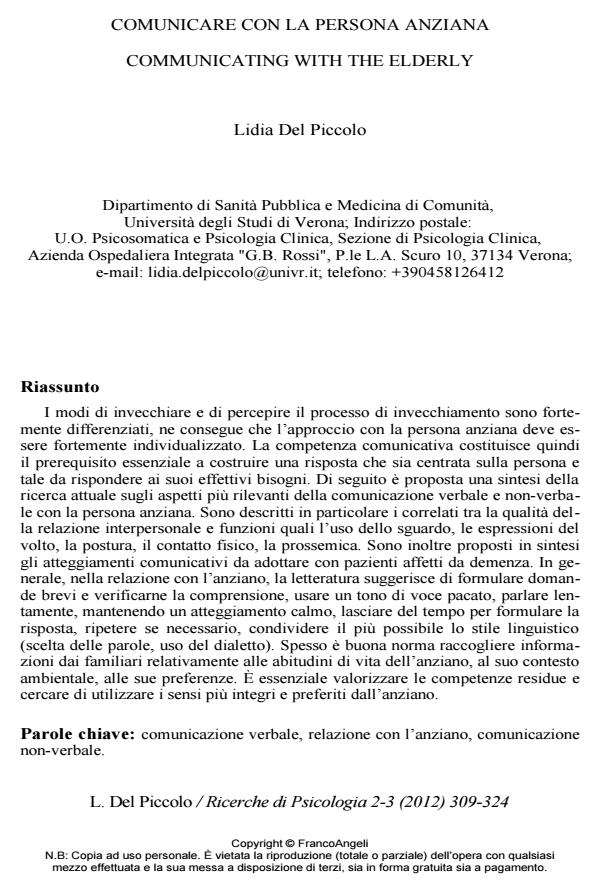Comunicare con la persona anziana
Titolo Rivista RICERCHE DI PSICOLOGIA
Autori/Curatori Lidia De Piccolo
Anno di pubblicazione 2013 Fascicolo 2012/2-3
Lingua Italiano Numero pagine 16 P. 309-324 Dimensione file 235 KB
DOI 10.3280/RIP2012-002011
Il DOI è il codice a barre della proprietà intellettuale: per saperne di più
clicca qui
Qui sotto puoi vedere in anteprima la prima pagina di questo articolo.
Se questo articolo ti interessa, lo puoi acquistare (e scaricare in formato pdf) seguendo le facili indicazioni per acquistare il download credit. Acquista Download Credits per scaricare questo Articolo in formato PDF

FrancoAngeli è membro della Publishers International Linking Association, Inc (PILA)associazione indipendente e non profit per facilitare (attraverso i servizi tecnologici implementati da CrossRef.org) l’accesso degli studiosi ai contenuti digitali nelle pubblicazioni professionali e scientifiche
I modi di invecchiare e di percepire il processo di invecchiamento sono fortemente differenziati, ne consegue che l’approccio con la persona anziana deve essere fortemente individualizzato. La competenza comunicativa costituisce quindi il prerequisito essenziale a costruire una risposta che sia centrata sulla persona e tale da rispondere ai suoi effettivi bisogni. Di seguito e proposta una sintesi della ricerca attuale sugli aspetti piu rilevanti della comunicazione verbale e non-verbale con la persona anziana. Sono descritti in particolare i correlati tra la qualita della relazione interpersonale e funzioni quali l’uso dello sguardo, le espressioni del volto, la postura, il contatto fisico, la prossemica. Sono inoltre proposti in sintesi gli atteggiamenti comunicativi da adottare con pazienti affetti da demenza. In generale, nella relazione con l’anziano, la letteratura suggerisce di formulare domande brevi e verificarne la comprensione, usare un tono di voce pacato, parlare lentamente, mantenendo un atteggiamento calmo, lasciare del tempo per formulare la risposta, ripetere se necessario, condividere il piu possibile lo stile linguistico (scelta delle parole, uso del dialetto). Spesso e buona norma raccogliere informazioni dai familiari relativamente alle abitudini di vita dell’anziano, al suo contesto ambientale, alle sue preferenze. E essenziale valorizzare le competenze residue e cercare di utilizzare i sensi piu integri e preferiti dall’anziano.
Parole chiave:Comunicazione verbale, relazione con l’anziano, comunicazione non-verbale.
Lidia De Piccolo, Comunicare con la persona anziana in "RICERCHE DI PSICOLOGIA " 2-3/2012, pp 309-324, DOI: 10.3280/RIP2012-002011